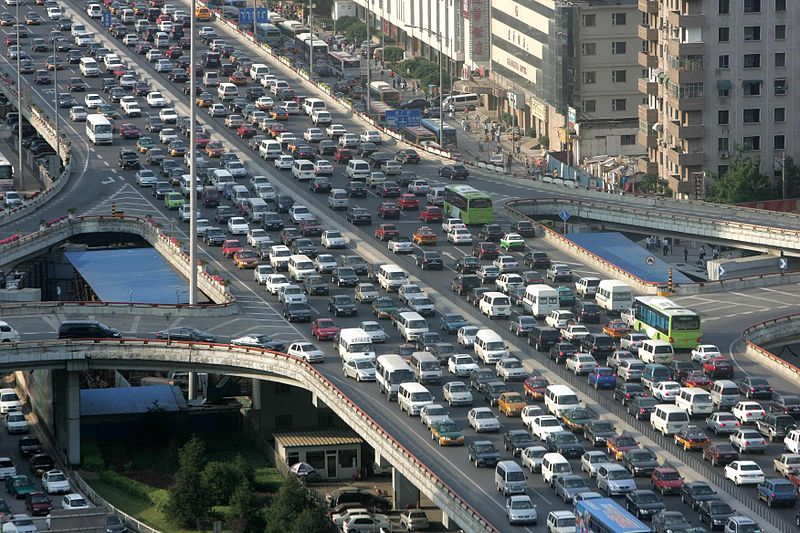
It looks like a science fiction landscape, but it's a sea stack in New Zealand, with Mount Taranaki is in the background. A "sea stack" forms when a cliff by the sea erodes, leaving a column of rock.
Thanks to some help from people on Google+, I eventually discovered
that this sea stack was one of the Three
Sisters on the Three Sisters beach, which is part of the
Tongaporutu coastline in New Zealand. Sometime in September 2003, the
"Little Sister" was knocked
down by a storm, leaving two.
August 2, 2011
Lisa and I took the train up from Beijing to Changchun along with
some other mathematicians heading for Higher Structures in China II
at Jilin University. The train ride took 6 hours and 20 minutes, going through
rural northern landscapes I'd never seen before. Lots of corn fields! We wondered what they did with all that corn until we happened to read a story about two big competing plants that make corn starch up in Changchun.
We were greeted by Yunh Sheng. He took us out to a Korean restaurant that serves dog. Everyone in our party was eyeing me expectantly as I took the first bite. I wowed them all by saying "Woof!" It tasted sort of like pork.
August 3, 2011
From the 3rd to 6th we went on an excursion to Baekdu Mountain, tallest of the Changbai Mountains. Most of the westerners in the party were sick some of the time. I only came down with
something near the end of the trip.
Some of us went to a show of er ren zhuan, a traditional entertainment in rural northern China. In the old days a couple would sing and dance using folded fans or red square handkerchiefs. Now it's gone modern. The dude here started with a smartass standup comedy act. Then his partner, dressed in some weird mix of traditional costume and white leather boots, swooped onstage and belted out a tune.


For some reason he had his forelocks shaped into little horns.
Then his wife came on stage and joked that while she was older than the other women we'd seen, she was still sexy. She flaunted a bit of skin near her waist to prove it. Then she wowed us with some cartwheels! And to wrap up the show, she threw on a blue wig with red devil horns and sang a song.

Cultural Square in Changchun, a northern city of 7.5 million, turns into a kind of fair on a summer night. Two guys were doing calligraphy with water on the sidewalk using sponge-tipped poles: write two verses and by then the first has evaporated so you can keep on writing. Fancy roller skating seems to be in vogue. So are kites with LEDs on them, a lot like here in Singapore.
But what really grabbed my attention is that girls age 10-18 are wearing flat plastic "hair bows" that light up in garish colors. It's not a real hair bow, more like a clip-on picture of a hair bow — so fake they make you look like a cartoon character! It's pretty hilarious.
August 13, 2011
I'm back in Singapore now. Here's some news about China, mostly from the 2 August 2011 edition of China Daily, the government's official English newspaper. As you'll see, they're pretty concerned about environmental problems.
The Chinese have fallen in love with cars. Though less than 6% of Chinese own cars so far, that's already 75 million cars, a market exceeded only by the US.
The price of real estate in China is shooting up---but as car ownership soars, you'll have to pay a lot more if you want to buy a parking lot for your apartment. The old apartments don't have them. In Beijing the average price of a parking lot is 140,000 yuan, which is about $22,000. In Shanghai it's 150,000 yuan. But in fancy neighborhoods the price can be much higher: for example, up to 800,000 yuan in Beijing!
For comparison, the average salary in Beijing was 36,000 yuan in 2007---and the median is probably much lower, since there are lots of poor people and just a few rich ones. On top of that, I bet this figure doesn't include the many undocumented people who have come from the countryside to work in Beijing. The big cities in China are much richer than the rest of the country: the average salary throughout the country was 11,000 yuan, and the average rural wage was just 3,600 yuan. This disparity is causing young people to flood into the cities, leaving behind villages mostly full of old folks.
Thanks to intensive use of coal, increasing car ownership and often-ignored regulations, air quality is bad in most Chinese cities. In Changchun, a typical summer day resembles the very worst days in Los Angeles, where the air is yellowish-grey except for a small blue region directly overhead.
In a campaign to improve the air quality in Beijing, drivers are getting subsidized to turn in cars made in 1995 or earlier. As usual, it's the old clunkers that stink the worst: 27% of the cars in Beijing are over 8 years old, but they make 60% of the air pollution. The government is hoping to eliminate 400,000 old cars and cut the emission of nitrogen oxide by more than 10,000 tonnes per year by 2015.
But this policy is also supposed to stoke the market for new automobiles. That's a bit strange, since Beijing is a huge city with massive traffic jams---some say the worst in the world! As a result, the government has taken strong steps to limit car sales in Beijing.

In Beijing, if you want to buy a car, you have to enter a lottery to get a license plate! Car sales have been capped at 240,000 this year, and for the first lottery people's chances of winning were just one in ten:
Why is the government trying to stoke new car sales in Beijing while simultaneously trying to limit them? Maybe it's just a rhetorical move to placate the car dealers, who hate the lottery system. Or maybe it's because the government makes money from selling cars: it's a state-controlled industry.
On another front, since July there has been a drought in the provinces of Gansu, Guizhou and Hunan, the Inner Mongolia autonomous region, and the Ningxia Hui autonomous region, which is home to many non-Han ethnic groups including the Hui. It's caused water shortages for 4.3 million people. In some villages all the crops have died. Drought relief agencies are sending out more water pumps and delivering drinking water.
In Gansu province, at least, the current drought is part of a bigger desertification process.
Once they grew rice in Gansu, but then they moved to wheat:
China is among the nations that are experiencing severe desertification. One of the hardest hit areas is Gansu Province, deep in the nation's heartland. The province, which includes parts of the Gobi, Badain Jaran, and Tengger Deserts, is suffering moisture drawdown year after year. As water goes up into the air, so does irrigation and agriculture. People can hardly make a living from the arid land.But the land was once quite rich and hospitable to agriculture, a far cry from what greets the eye today. Ruoli, in central Gansu, epitomizes the big dry-up. The area used to be verdant farmland where, with abundant rainfall, all kinds of plants grew lush and dense; but now the land is dry and yields next to nothing. All this dramatic change has come about in just 50 years.lightning-fast, a mere blink of an eye in geological terms.
Rapid desertification is forcing many parties, including the government, to take action. Some residents have moved away to seek better livelihoods elsewhere, and the government offers incentives for people to relocate to the lowlands Tzu Chi built a new village to accommodate some of these migrants.
Tzu Chi is a Buddhist organization with a strong interest in climate change. The dramatic change they speak of seems to be part of a longer-term drying trend in this region. Here is one of a series of watchtowers near Dunhuang, once a thriving city at the eastern end of the Silk Road. I don't think this area was such a desert back then:
Meanwhile, down in southern China, the Guanxi Zhuang autonomous region is seeing its worst electricity shortage in the last 2 decades, with 30% of the demand for electric power unmet, and rolling blackouts. They blame the situation on a shortage of coal and the fact that the local river isn't deep enough to provide hydropower.
On the bright side, China is investing a lot in wind power. Their response to the financial crisis of of 2009 included $220 billion investment in renewable energy. Baoding province is now one of the world's centers for producing wind turbines, and by 2020 China plans to have 100 gigawatts of peak wind power online.
That's pretty good! Remember our discussion of Pacala and Socolow's stabilization wedges? The world needs to reduce carbon emissions by roughly 10 gigatonnes per year by about 2050 to stay out of trouble. Pacala and Socolow call each 1-gigatonne slice of this carbon pie a 'wedge'. We could reduce carbon emissions by one 'wedge' by switching 700 gigawatts of coal power to 2000 gigawatts of peak wind power. Why 700 of coal for 2000 of wind? Because unfortunately most of the time wind power doesn't work at peak efficiency!
So, the Chinese plan to do 1/20 of a wedge of wind power by 2020. Multiply that effort by a factor of 200 worldwide by 2050, and we'll be in okay shape. That's quite a challenge! Of course we won't do it all with wind.
And while the US and Europe are worried about excessive government and private debt, China is struggling to figure out how to manage its vast savings. China has a $3.2 trillion foreign reserve, which is 30% of the world's total. The fraction invested in the US dollars has dropped from 71% in 1999 to 61% in 2010, but that's still a lot of money, so any talk of the US defaulting, or a drop in the dollar, makes the Chinese government very nervous. This article goes into a bit more detail:
In a move to keep the value of their foreign reserves and improve their ratio of return, an increasing number of countries have set up sovereign wealth funds in recent years, especially since the onset of the global financial crisis. So far, nearly 30 countries or regions have established sovereign wealth funds and the total assets at their disposal amounted to $3.98 trillion in early 2011.Compared to its mammoth official foreign reserve, China has made much slower progress than many countries in the expansion of its sovereign wealth funds, especially in its stock investments. Currently, China has only three main sovereign wealth funds: One with assets of $347.1 billion is managed by the Hong Kong-based SAFE Investment Co Ltd; the second, with assets of $288.8 billion, is managed by the China Investment Corporation, a wholly State-owned enterprise engaging in foreign assets investment; the third fund of $146.5 billion is managed by the National Social Security Fund.
From the perspective of its investment structure, China's sovereign wealth funds have long attached excessive importance to mobility and security. For example, the China Investment Corporation has invested 87.4 percent of its funds in cash assets and only 3.2 percent in stocks, in sharp contrast to the global average of 45 percent in stock investments.
What's interesting to me is that on the one hand we have these big problems, like global warming, and on the other hand these people with tons of money struggling to find good ways to invest it. Is there a way to make each of these problems the solution to the other?
© 2011 John Baez
baez@math.removethis.ucr.andthis.edu